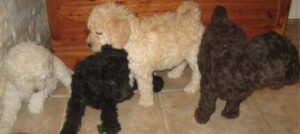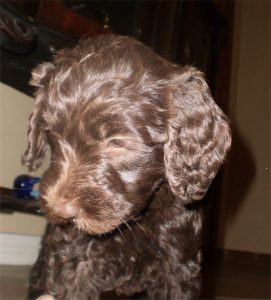

Labradoodle Temperament
Labradoodles are sociable, friendly, clever, non – aggressive, and extremely intuitive. Their intelligence and high train-ability make them well suited for guide dogs, therapy dogs, and other assistance dogs. The puppy pictured here is just days old and is already comfortable being handled and held on its back. (part of early neurological stimulation)
The tendency to have non-allergic coats make them popular among people who have not been able to enjoy pets because of their allergies. Although the labradoodle puppies can be active, adults are rated a “medium” in activity and “average” for exercise needs. Labradoodles get along well with other dogs, and children. They are quick to learn unusual or special tasks, and are known to be comical. They will attempt to outsmart their owners if undisciplined. They are friendly, though loyal to their own family. Most labradoodle pups inherit a nice mix of temperament and as such make wonderful companions for the entire family. In many breeds, males tend to be more dominate and females sweeter and more laid back. With Labradoodles, this is not true. Care was taken from the very beginning to eliminate dominate males from the breeding stock. Our stud dogs are more meek and submissive than our females, and if pups are de-sexed before six months, testosterone related behaviors typically associated with male dogs never develop. Therefore, gender should not be a factor when choosing a puppy.
Labradoodles crave companionship from their human families. If you want a dog to live outside in the yard, and just be around it when you feed it, or want a guard dog, don’t get a Labradoodle. They love you and need your time and attention.
Sizes
The three sizes of Labradoodles are currently distinguished as follows:
- Standards are 21 – 26 inches tall
- Mediums are 17 – 21 inches tall
- Miniatures are 14 – 17 inches tall
Weight
Currently, weight is approximately as follows:
- Standards: 50-65 pounds
- Mediums: 30-50 pounds
- Miniatures: 16-30 pounds (THIS IS THE SIZE WE ARE CURRENTLY BREEDING)
Coat
Labradoodles are bred to have either the easy care fleece coat or the non-shedding wool curly coat. The fleece coat is low-shedding to non-shedding and allergy friendly. It hangs in loose loopy curls. fleece coats are lower maintenance, but may experience some shedding. The wool coat is nearly always non-shedding, resembles that of a poodle and feels like a soft wool sweater. For some photos of dogs we bred as puppies and as adults click here.
Colors
Labradoodles comes in a variety of colors including: White, Chalk, Cream, Apricot, Gold, Caramel, Red, Black, Chocolate, Café au Lait, Parchment, Parti and the very rare color, Merle (which we are now producing). In the past, we have had phenomenal litters with most of the colors above.
